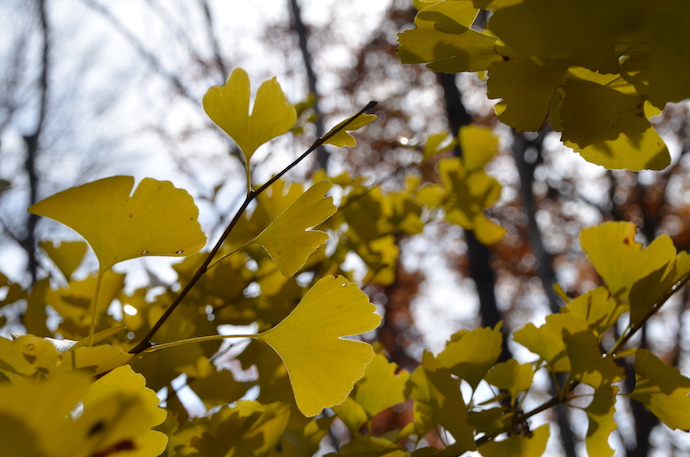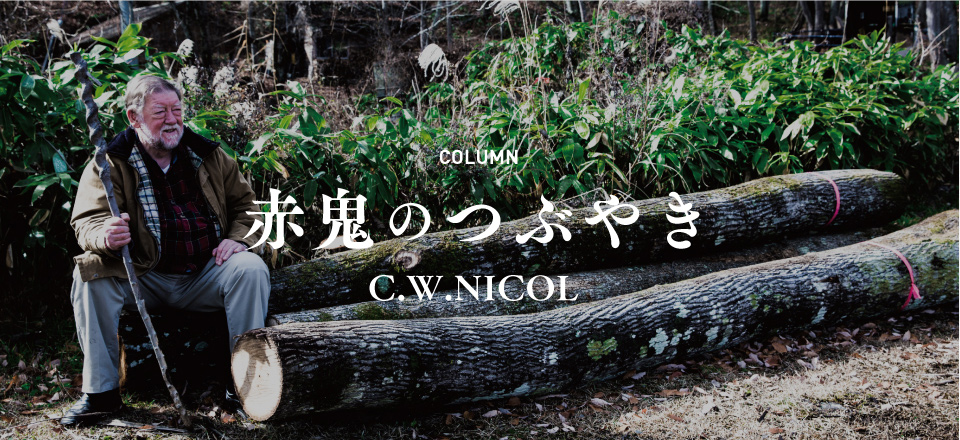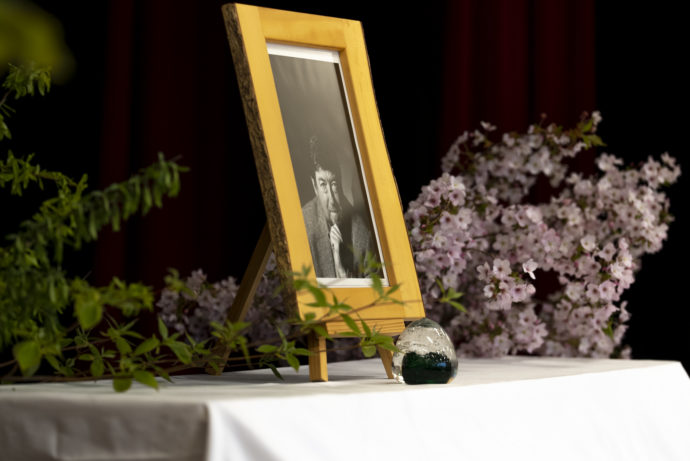Column
【赤鬼のつぶやき C.W.ニコル】イチョウ(Ginkgo)

銀杏(イチョウ、ギンコウ)
イチョウは、英語でギンコウと呼ばれます。昔、オーストラリア人の親友にこう言ったことがあります。「君こそギンコウマンだ。」彼は世界銀行に勤めていて、ギンナンの実のように青白くて丸いものを持っていたからです。自分は女性にモテると自惚れているタイプの彼は、このジョークをわかってくれたでしょうか。
アファンの森に、一本のイチョウがあります。もう引退してしまった森の番人の松木さんとわたしが16年も前に植えたものです。アファンの森を財団に託す前のことでした。今では、もともと森に生えている樹種でなければ植えてはいけないということになっていますが、以前は、わたしと松木さんで話し合って決めていました。会話や議論を豊かにする森づくりのためには、時にはそれも必要なことがあったのです。
イチョウの木は、日本を訪れたヨーロッパの人間が最初に発見した記録が残っています。そして化石の記録では、ダイノサイウルスが地上を闊歩していた2億7千年前、人類が誕生するよりずっと昔から地上に存在していました。そして、中国から日本に持ち込まれたのは数百年以上前に遡ります。
そしてヨーロッパに根付いたのは300年前、北米では200年程度のことです。25メートルから35メートルになる大きな木で、都会では空気の汚れにも強く、狭いところにも植えることができるので、街路樹として人気があります。東京都の木としてもおなじみです。


イチョウの木は、雌と雄があります。成熟した雌の木にはひどく臭う実が付き、果肉に触れるとかぶれを起こします。種には、厚みがないにも関わらず硬い殻に包まれているのは緑色の実が入っていて、とても美味しいです。日本ではギンナンの実といえばまずは茶碗蒸し、他にもいろいろな調理法が中華や和食には知られています。
アヒルの足のようなかたちの葉っぱはアルツハイマーなどの認知症に効果があるそうです(わたしも友人からイチョウの葉を摂ってみるべきだとよく言われたものですが、なんのために使うのかをすっかり忘れてしまうのが問題)。医療の専門家によると、他の漢方薬と同じように、この葉の効果についても科学的にはまだ証明されていないようです。
強くて、美しく、気が遠くなるほど長い間、生き続けることができるイチョウ。秋になると、鮮やかな金色に紅葉して風景を染めます。まさかこれを切り倒して薪や材木にしようと考える人はいないのではないでしょうか。イチョウ材の使い途についてインターネットで調べていると、中国では彫刻に使われることがあり、固く、黄色みのかかった材は彫りやすいようです。他にもギターの胴や調理用のカッティングボードを作ったり、日本ではお椀に加工されます。
松木さんとふたりで植えた木は順調に育っていて、高さは7メートルほどになりました。我々がこの世からいなくなった後、大きなイチョウを見上げながらアファンの森を散策する人々の眼に映るこの木のことを想像します。精力旺盛なギンコウマンがギンナンの実を食べていたかどうかは、知る由もありませんが。
C.W. ニコル
2016年12月
写真提供:C.W.ニコル・アファンの森財団
GINKGO
I have a very dear Australian friend, a world banker, who, despite nearing his seventies, still fancies himself as a ladies’ man. I once told him that his is a ‘real gingko man’ because his nuts are small and green. I’m not sure if he got the joke.
Of all the trees in our Afan woods the rarest is probable a gingko tree, which was planted by our now retired forest Mr. Matsuki and myself about sixteen years ago, before I donated the woodland to the Afan Woodland Trust. The official policy of the trust nowadays is to only plant trees which were traditionally there. However, in the old days when Mr. Matsuki and myself made all decisions, we sometimes planted different trees in order to inspire conversation and discussion.
‘Gingko balboa’ trees were first recorded by European visitors to Japan in 1690. They were common in temple gardens. The gingko tree is probably the oldest living species of tree on our planet. Fossil records trace it back to 270 million years, so the gingko was growing when great dinosaurs roamed earth, long before man. Living gingko trees are native to China, but, as I said, were introduced to Japan hundreds of years ago.
It has been cultivated in Europe for 300 years now, and in North America for over 200 years. Reaching heights of 20 to 35 metres, and being very tolerant to city pollution and restricted space, it is a very favoured ornamental tree. The gingko is of course, the symbol tree of Tokyo.
The ginkgo has both male and female trees, with the mature female producing a foul-smelling fruit whose flesh can cause skin troubles in humans. However, the thin but hard shell when roasted and opened produces a small green nut, which I find quite delicious. In Japan these green nuts are commonly used in ‘chawanmushi’ dishes, but its use in other Japanese and Chinese cookery is quite common.
Gingko duck foot-shaped leaves have become popular in supplement herbal medicines for treating or preventing cognitive functions such as Alzheimer’s disease and dementia. (Friends have recommended their use to me, but I forget what for) However, like so many herbal remedies, the medical profession is unsure of their effectiveness.
Ginkgo trees can and do live to magnificent old age, mighty, spectacular trees with glorious yellow-gold autumn foliage. One doesn’t often hear about them being cut down and used for firewood or lumber! I had to do some Internet research into the use of gingko timber and found that, especially in China, the wood is especially favoured for carving. It is apparently a hard, yellowish wood that is relatively easy to carve. I also found references to gingko wood being used for making guitar bodies, and in some places in Japan, for making lacquered rice bowls and even cutting boards.
The tree that Matsuki-san and I planted is now about seven metres in height and growing well. Many years after we have both gone I imagine people walking in our Afan woods and seeing a huge gingko tree, wondering how it got there. Whatever, it has nothing to do with lecherous bankers and their little green nuts.
C.W.Nicol
December 2016
C.W.ニコル
作家・1940年イギリス南ウェールズ生まれ。1995年日本国籍取得。カナダ水産調査局北極生物研究所の技官・環境局の環境問題緊急対策官やエチオピアのシミエン山岳国立公園の公園長など世界各地で環境保護活動を行い、1980年から長野県在住。1984年から荒れ果てた里山を購入し「アファンの森」と名づけ、森の再生活動を始める。2005年、その活動が認められエリザベス女王から名誉大英勲章を賜る。2011年、2016年に天皇、皇后両陛下がアファンの森をご視察された。





